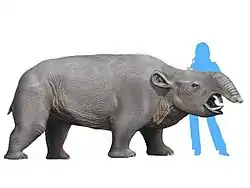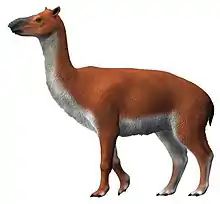| Meridiungulata Temporal range: | |
|---|---|
 | |
| Toxodon, a notoungulate | |
_(14749571352).jpg.webp) | |
| Thesodon, a litoptern | |
| Scientific classification | |
| Domain: | Eukaryota |
| Kingdom: | Animalia |
| Phylum: | Chordata |
| Class: | Mammalia |
| Infraclass: | Placentalia |
| Clade: | †Meridiungulata McKenna 1975 |
| Orders | |
South American native ungulates, commonly abbreviated as SANUs, are extinct ungulate-like mammals of controversial affinities that were indigenous to South America prior to the Great American Biotic Interchange. They comprise five major groups conventionally ranked as orders—Astrapotheria, Litopterna, Notoungulata, Pyrotheria, and Xenungulata—as well as the primitive "condylarth" groups Didolodontidae and Kollpaniinae. It has been proposed that some or all of the members of this group form a clade, named Meridiungulata, though the relationships of South American ungulates remain largely unresolved. The two largest groups of South American ungulates, the notoungulates and the litopterns, were the only groups to persist beyond the mid Miocene. Only a few of the largest species of notoungulates and litopterns survived until the end-Pleistocene extinction event around 12,000 years ago where they became extinct with most other large mammals in the Americas, shortly after the first arrival of humans into the region.
Though most SANUs lived in South America, astrapotheres and litopterns are known from Eocene aged deposits in the Antarctic Peninsula[1] and the notoungulate Mixotoxodon spread as far north as what is now Texas during the Pleistocene as part of the Great American Biotic Interchange.[2]
Taxonomy
Meridiungulata might have originated in South America from a North American condylarth ancestor,[3] and they may be members of the clade Laurasiatheria, related to other ungulates, including artiodactyls and perissodactyls.[4] It has, however, been suggested the Meridiungulata are part of a different macro-group of placental mammals called Atlantogenata.[5]
Much of the evolution of meridiungulates occurred in isolation from other ungulates, a great example of convergent evolution. However, the argument that meridiungulates are related to artiodactyls and perissodactyls needs support from molecular sequencing. Some paleontologists have also challenged the monophyly of Meridiungulata by suggesting that the pyrotheres are more closely related to other mammals, such as Embrithopoda (an African order possibly related to elephants), than to other South American ungulates.[6]
Molecular sequence data from both collagen[7][8] and mitochondrial DNA[9] supports that litopterns and notoungulates are most closely related to Perissodactyla (the group containing equids, rhinoceroses, and tapirs) among living mammals, as part of the clade Panperissodactyla, which has also been supported by some analyses of morphology.[10][11] However, other morphological analyses have placed Litopterna elsewhere within Laurasiatheria.[12][13] Didolodontids may be closely related to litopterns,[12][14] and it has been proposed that they should be classified within Litopterna,[15] but some analyses do not find them to be close relatives.[10][11]
Molecular sequence data from collagen suggests Notoungulata and Litopterna are more closely related to each other than to Perissodactyla, suggesting that at least part of Meridiungulata is monophyletic.[7][8] By contrast, morphology-based analyses have found a range of possible positions for notoungulates. They have been found to be elsewhere within Laurasiatheria,[13] within Afrotheria,[12][14][16] and as stem-group atlantogenatans.[13] A position within Afrotheria has been argued to be unlikely on biogeographic grounds, and some of the afrotherian characteristics present in notoungulates have been refuted.[1]
Litopterns and notoungulates are the only South American ungulates to have gone extinct recently enough for molecular data to be available, so the relationships of astrapotheres, pyrotheres, and xenungulates must be determined based on morphology alone.[8][1]
The clade Sudamericungulata has been proposed to encompass astrapotheres, notoungulates, pyrotheres, and xenoungulates but not litopterns.[14] Such a clade had been found in previous studies, but left unnamed.[16][11] The study proposing the name Sudamericungulata found them to be afrotheres.[14] The study proposing Sudamericungulata was questioned in a later study, who suggested that the taxon and character sampling in the analysis was poor (including only a single perissodactyl), and that the placement of Sudamericungulata within Afrotheria was not robustly supported, and that a placement within Laurasiatheria was supported for Sudamericungulata and Litopterna when Afrotheria and Laurasiatheria were constrained to be monophyletic by molecular results.[17]
Notes
- 1 2 3 Croft, Gelfo & López 2020.
- ↑ Lundelius et al. 2013.
- ↑ Muizon & Cifelli 2000
- ↑ Hunter & Janis 2006
- ↑ Naish 2008
- ↑ Shockey & Anaya 2004
- 1 2 Buckley 2015.
- 1 2 3 Welker et al. 2015.
- ↑ Westbury et al. 2017.
- 1 2 Chimento & Agnolin 2020.
- 1 2 3 MacPhee et al. 2021.
- 1 2 3 O'Leary et al. 2013.
- 1 2 3 Halliday, Upchurch & Goswami 2017.
- 1 2 3 4 Avilla & Mothé 2021.
- ↑ Gelfo, López & Lorente 2016.
- 1 2 de Muizon et al. 2015.
- ↑ Kramarz, Alejandro G.; Macphee, Ross D. E. (March 2023). "Did some extinct South American native ungulates arise from an afrothere ancestor? A critical appraisal of Avilla and Mothé's (2021) Sudamericungulata – Panameridiungulata hypothesis". Journal of Mammalian Evolution. 30 (1): 67–77. doi:10.1007/s10914-022-09633-5. ISSN 1064-7554. S2CID 253433775.
References
- Avilla, Leonardo S.; Mothé, Dimila (2021). "Out of Africa: A New Afrotheria Lineage Rises From Extinct South American Mammals". Frontiers in Ecology and Evolution. 9. doi:10.3389/fevo.2021.654302. ISSN 2296-701X.
- Buckley, M. (2015-04-01). "Ancient collagen reveals evolutionary history of the endemic South American 'ungulates'". Proceedings of the Royal Society B: Biological Sciences. 282 (1806): 20142671. doi:10.1098/rspb.2014.2671. PMC 4426609. PMID 25833851.
- Chimento, Nicolás R.; Agnolin, Federico L. (2020). "Phylogenetic tree of Litopterna and Perissodactyla indicates a complex early history of hoofed mammals". Scientific Reports. 10 (1): 13280. doi:10.1038/s41598-020-70287-5. hdl:11336/135739. ISSN 2045-2322. PMC 7413542. PMID 32764723.
- Croft, Darin A.; Gelfo, Javier N.; López, Guillermo M. (2020). "Splendid Innovation: The Extinct South American Native Ungulates". Annual Review of Earth and Planetary Sciences. 48 (1): 259–290. doi:10.1146/annurev-earth-072619-060126. ISSN 0084-6597. S2CID 213737574.
- de Muizon, Christian; Billet, Guillaume; Argot, Christine; Ladevèze, Sandrine; Goussard, Florent (2015). "Alcidedorbignya inopinata, a basal pantodont (Placentalia, Mammalia) from the early Palaeocene of Bolivia: anatomy, phylogeny and palaeobiology". Geodiversitas. 37 (4): 397. doi:10.5252/g2015n4a1. ISSN 1280-9659. S2CID 131556174.
- Halliday, Thomas J. D.; Upchurch, Paul; Goswami, Anjali (2017). "Resolving the relationships of Paleocene placental mammals: Paleocene mammal phylogeny". Biological Reviews. 92 (1): 521–550. doi:10.1111/brv.12242. ISSN 1464-7931. PMC 6849585. PMID 28075073.
- Hunter, J.P.; Janis, C.M. (2006). "Spiny Norman in the Garden of Eden? Dispersal and early biogeography of Placentalia". Journal of Mammalian Evolution. 13 (2): 89–123. doi:10.1007/s10914-006-9006-6. OCLC 4669969299. S2CID 41292696.
- Gelfo, Javier N.; López, Guillermo M.; Lorente, Malena (2016). "Los ungulados arcaicos de América del Sur: "Condylarthra" y Litopterna". Contribuciones del MACN. 6: 285–291. ISSN 1666-5503.
- MacPhee, R.D.E.; Del Pino, Santiago Hernández; Kramarz, Alejandro; Forasiepi, Analía M.; Bond, Mariano; Sulser, R. Benjamin (2021). "Cranial Morphology and Phylogenetic Relationships of Trigonostylops wortmani, an Eocene South American Native Ungulate". Bulletin of the American Museum of Natural History. 449 (1). doi:10.1206/0003-0090.449.1.1. ISSN 0003-0090. S2CID 233301560.
- McKenna, M.C. (1975). "Toward a phylogenetic classification of the Mammalia". In Luckett, W.P.; Szalay, F.S. (eds.). Phylogeny of the primates: a multidisciplinary approach (Proceedings of WennerGren Symposium no. 61, Burg Wartenstein, Austria, July 6–14, 1974. New York: Plenum. pp. 21–46. doi:10.1007/978-1-4684-2166-8_2. ISBN 978-1-4684-2168-2.
- Muizon, C. de; Cifelli, R.L. (2000). "The "condylarths" (archaic Ungulata, Mammalia) from the early Paleocene of Tiupampa (Bolivia): implications on the origin of the South American ungulates". Geodiversitas. 22 (1): 47–150. Retrieved 30 June 2017.
- Lundelius, E. L.; Bryant, V. M.; Mandel, R.; Thies, K. J.; Thoms, A. (2013). "The first occurrence of a toxodont (Mammalia, Notoungulata) in the United States". Journal of Vertebrate Paleontology. 33 (1): 229–232. Bibcode:2013JVPal..33..229L. doi:10.1080/02724634.2012.711405. hdl:1808/13587. S2CID 53601518.
- Naish, Darren (2008-02-08). "Snorki the giant's friends and relatives". Tetrapod Zoology. Archived from the original on 21 May 2013. Retrieved 2014-10-07.
- O'Leary, Maureen A.; Bloch, Jonathan I.; Flynn, John J.; Gaudin, Timothy J.; Giallombardo, Andres; Giannini, Norberto P.; Goldberg, Suzann L.; Kraatz, Brian P.; Luo, Zhe-Xi; Meng, Jin; Ni, Xijun; Novacek, Michael J.; Perini, Fernando A.; Randall, Zachary S.; Rougier, Guillermo W.; Sargis, Eric J.; Silcox, Mary T.; Simmons, Nancy B.; Spaulding, Michelle; Velazco, Paúl M.; Weksler, Marcelo; Wible, John R.; Cirranello, Andrea L. (2013). "The Placental Mammal Ancestor and the Post–K-Pg Radiation of Placentals". Science. 339 (6120): 662–667. doi:10.1126/science.1229237. hdl:11336/7302. PMID 23393258. S2CID 206544776.
- Rose, Kenneth David (2006). The beginning of the age of mammals. Baltimore: JHU Press. ISBN 978-0801884726.
- Shockey, B.J.; Anaya, F. (2004). "Pyrotherium macfaddeni, sp. nov. (late Oligocene, Bolivia) and the pedal morphology of pyrotheres". Journal of Vertebrate Paleontology. 24 (2): 481–488. doi:10.1671/2521. S2CID 83680724.
- Welker, F.; Collins, M. J.; Thomas, J. A.; Wadsley, M.; Brace, S.; Cappellini, E.; Turvey, S. T.; Reguero, M.; Gelfo, J. N.; Kramarz, A.; Burger, J.; Thomas-Oates, J.; Ashford, D. A.; Ashton, P. D.; Rowsell, K.; Porter, D. M.; Kessler, B.; Fischer, R.; Baessmann, C.; Kaspar, S.; Olsen, J. V.; Kiley, P.; Elliott, J. A.; Kelstrup, C. D.; Mullin, V.; Hofreiter, M.; Willerslev, E.; Hublin, J.-J.; Orlando, L.; Barnes, I.; MacPhee, R. D. E. (2015-03-18). "Ancient proteins resolve the evolutionary history of Darwin's South American ungulates". Nature. 522 (7554): 81–84. doi:10.1038/nature14249. hdl:11336/14769. ISSN 0028-0836. PMID 25799987. S2CID 4467386.
- Westbury, M.; Baleka, S.; Barlow, A.; Hartmann, S.; Paijmans, J. L. A.; Kramarz, A.; Forasiepi, A. M.; Bond, M.; Gelfo, J. N.; Reguero, M. A.; López-Mendoza, P.; Taglioretti, M.; Scaglia, F.; Rinderknecht, A.; Jones, W.; Mena, F.; Billet, G.; de Muizon, C.; Aguilar, J. L.; MacPhee, R. D. E.; Hofreiter, M. (2017-06-27). "A mitogenomic timetree for Darwin's enigmatic South American mammal Macrauchenia patachonica". Nature Communications. 8: 15951. doi:10.1038/ncomms15951. PMC 5490259. PMID 28654082.




.jpg.webp)



